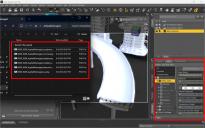Where to put png texture to obj?
Hi all,
I’ve imported an OBJ file into DAZ Studio and have the textures in PNG format, but I’m not sure where to place them in the right slots (like normal, roughness, etc.). Could someone guide me on how to set this up properly?
Thanks in advance!


screenshot20240907172457_1.jpg
2560 x 1600 - 315K


Comments
Check this thread - https://www.daz3d.com/forums/discussion/comment/8838836/#Comment_8838836
Seems like someone asks this every other day. You would think at some point someone would make an official guide that we could link to but guess not.
When using the Iray Uber Shader:
Roughness Maps -> Glossy Roughness (glossy layer weight should be set to 1.0 and Glossy Roughness value should be 1.0 also) Note: you can also use Specular to control Glossy effect instead of the Glossy Group parameters. You can read around Specular group properties for iray uber if you want to go that route, but using the Glossy Group should be fine.
Normal Maps -> Normal, value should be 1.0
Height -> Bump, Value should be 10+? (Personally im not sure of what value to use for Bump to be honest, you can eyeball what looks good). If the height map is actually a displacement map, it can be put under displacement slot, but I would assume most height maps are bump maps unless instructed otherwise.
Metallic -> Metallicity, value should be 1.0
Baecolor ->Base Color
AO -> You can ignore this, as you dont technically need AO when rendering in a ray tracing renderer like Iray. AO is just baked shadows, usually good for using in game engines that are real time and not ray tracers. If you want the baked shadows, you could use it as mask in layered image editor. Up to you.
Note: sometimes people will package completely empty maps. If a map is completely black or completely white, you should just discard those, as those are equivalent to setting value to 0.0 or 1.0 in the channel respectively, so can just use the value, not the map.
Thank you so much for this, but what about Refraction? Where should I put it?
Its hard to really give guidance on that without knowing what the surface looks like you are applying the maps to.
Without any further info, i would start from an existing glass shader. Which is to say, apply one of the default iray glass shaders. Then you could use those maps to make adjustments to the shader, if needed, by adding them to the relevant active channels on the glass shaders. I would test what the effect does in iray preview mode.
Im assuming the refraction map is just a mask for the refraction effect, so after applying the default glass shader, the refraction map should probably go on the Refraction Weight channel, but hard to really say what the author's intent was with that Refraction map, since (a) you didnt show a preview of the map or the surface it is supposed to be applied to and (b) the file author has a bunch of random maps in there like Metallicity for glass, so makes me think maybe there are window frames involved on the same surface or the author is stupid and included a blank metallicity map...
Edit: Accidentally wrote Refractive Index but meant Refractive Weight
You also need to check / tweak the surface settings after assigning the texture maps. Those maps on the assets from kitbash3d ,etc. may not be optimized even applicable for Iray engine. And the promo images of the products were rendered by other engines, so in most of the cases, you won't directly get the same result by rendering with Iray in DS...